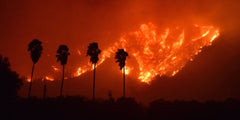
It's our home, too.
We launched Uncharted in a small apartment near Santa Monica, and watching SoCal burn over the past few days has hit home. We’ve received hundreds of calls and texts from people asking for advice, gear and more.
Fires are traveling at incredible speeds, often consuming areas the size of a football field in just a few seconds. We wanted to give people a game plan to help safely navigate these scary moments. Please read on:
BREATHE
In any situation, the first thing you want to do is breathe clean air. You can go days without water, and weeks without food, but without oxygen, you last only a few moments. Additionally, breathing bad / dirty air can have long lasting effects. Smoke is made up of a complex mixture of gases and fine particles produced when wood and other organic materials burn. The biggest health threat from smoke is from fine particles. These microscopic particles can penetrate deep into your lungs and exposure to particle pollution is linked to a variety of health issues, including premature death.
Get an air mask on, and keep it on. Anything is better than nothing. You can find a variety of masks at hardware stores, military surplus stores, and more. If you don’t have access to one, simply dampening a t-shirt, and wrapping it around your head will help filter SOME of the particulate matter, and provide some coverage until a better solution is available.
WATER, GOGGLES, GLOVES AND SHOES
The beauty of water is that it’s readily available in your home. Fill up a bunch of containers and keep them in your car, at work and at home. Whether your water shuts off, or you simply can’t get to it, this can be life or death when dealing with ash, heat and smoke.
If you have to be out in the elements, be sure to protect your eyes, hands and feet. There’s nothing more important than the ability to see what’s going on, and be able to move. Keep a pair of goggles, gloves and sturdy running/hiking shoes in your car, or with your survival equipment and supplies.
LISTEN TO AUTHORITIES
Unless a situation gets really bad, you can likely get all the info you need on your smartphone. It’s not a bad idea to keep an emergency weather radio handy as well. If cell towers go down, radio broadcasts are more likely to continue working, will reach much further distances and will give you instruction from local authorities on where to go and what the latest conditions are.
KEEP YOUR CAR GASSED UP
You never know when an evacuation may happen in your neighborhood. Keeping your car topped off in times like this will ensure you can move quickly and without delay, avoiding the long lines at the gas stations. Sometimes seconds can make a huge difference.
PLAN AHEAD
If you still have time to take precautionary measures, or if you want to be more prepared for the next time, follow the 6 Ps:
- People and Pets- Have a plan. Do you know at least two ways out of your community? Where will you meet family after evacuation? Where will you stay and how will you contact each other? Where will your pets stay?
- Papers, phone numbers, and important documents. Deeds, birth certificates and other irreplaceable documents should be in one location so these can be grabbed at a moment’s notice.
- Prescriptions, eyeglasses, and vitamins. You may be gone from your home for days, so insure you have access to all your health related items.
- Pictures and irreplaceable memorabilia. These are priceless and could be lost forever.
- Personal computers or any information stored on hard drives and disks.
- Plastic including credit cards, ATM cards and cash.
If you have any questions, tweet or email us. We’re here to help.